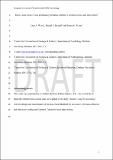Files in this item
Does a peer model's task proficiency influence children's solution choice and innovation?
Item metadata
| dc.contributor.author | Wood, L. A. | |
| dc.contributor.author | Kendal, Rachel L. | |
| dc.contributor.author | Flynn, Emma G. | |
| dc.date.accessioned | 2017-01-03T00:32:06Z | |
| dc.date.available | 2017-01-03T00:32:06Z | |
| dc.date.issued | 2015-11 | |
| dc.identifier | 204849459 | |
| dc.identifier | 7cf4e2ce-45ea-40ee-b3f6-a4971226c3f8 | |
| dc.identifier | 84934287840 | |
| dc.identifier | 000359171500013 | |
| dc.identifier.citation | Wood , L A , Kendal , R L & Flynn , E G 2015 , ' Does a peer model's task proficiency influence children's solution choice and innovation? ' , Journal of Experimental Child Psychology , vol. 139 , pp. 190-202 . https://doi.org/10.1016/j.jecp.2015.06.003 | en |
| dc.identifier.issn | 0022-0965 | |
| dc.identifier.uri | https://hdl.handle.net/10023/10034 | |
| dc.description | This work was supported by a Durham Doctoral Fellowship to L.A.W. | en |
| dc.description.abstract | The current study investigated whether 4- to 6-year-old children's task solution choice was influenced by the past proficiency of familiar peer models and the children's personal prior task experience. Peer past proficiency was established through behavioral assessments of interactions with novel tasks alongside peer and teacher predictions of each child's proficiency. Based on these assessments, one peer model with high past proficiency and one age-, sex-, dominance-, and popularity-matched peer model with lower past proficiency were trained to remove a capsule using alternative solutions from a three-solution artificial fruit task. Video demonstrations of the models were shown to children after they had either a personal successful interaction or no interaction with the task. In general, there was not a strong bias toward the high past-proficiency model, perhaps due to a motivation to acquire multiple methods and the salience of other transmission biases. However, there was some evidence of a model-based past-proficiency bias; when the high past-proficiency peer matched the participants' original solution, there was increased use of that solution, whereas if the high past-proficiency peer demonstrated an alternative solution, there was increased use of the alternative social solution and novel solutions. Thus, model proficiency influenced innovation. | |
| dc.format.extent | 13 | |
| dc.format.extent | 1108063 | |
| dc.language.iso | eng | |
| dc.relation.ispartof | Journal of Experimental Child Psychology | en |
| dc.subject | Trust | en |
| dc.subject | Social learning | en |
| dc.subject | Proficiency | en |
| dc.subject | Innovation | en |
| dc.subject | Transmission biases | en |
| dc.subject | Canalization | en |
| dc.subject | BF Psychology | en |
| dc.subject.lcc | BF | en |
| dc.title | Does a peer model's task proficiency influence children's solution choice and innovation? | en |
| dc.type | Journal article | en |
| dc.contributor.institution | University of St Andrews. School of Biology | en |
| dc.identifier.doi | https://doi.org/10.1016/j.jecp.2015.06.003 | |
| dc.description.status | Peer reviewed | en |
| dc.date.embargoedUntil | 2017-01-02 | |
| dc.identifier.url | http://www.sciencedirect.com/science/article/pii/S0022096515001459#appd002 | en |
This item appears in the following Collection(s)
Items in the St Andrews Research Repository are protected by copyright, with all rights reserved, unless otherwise indicated.

